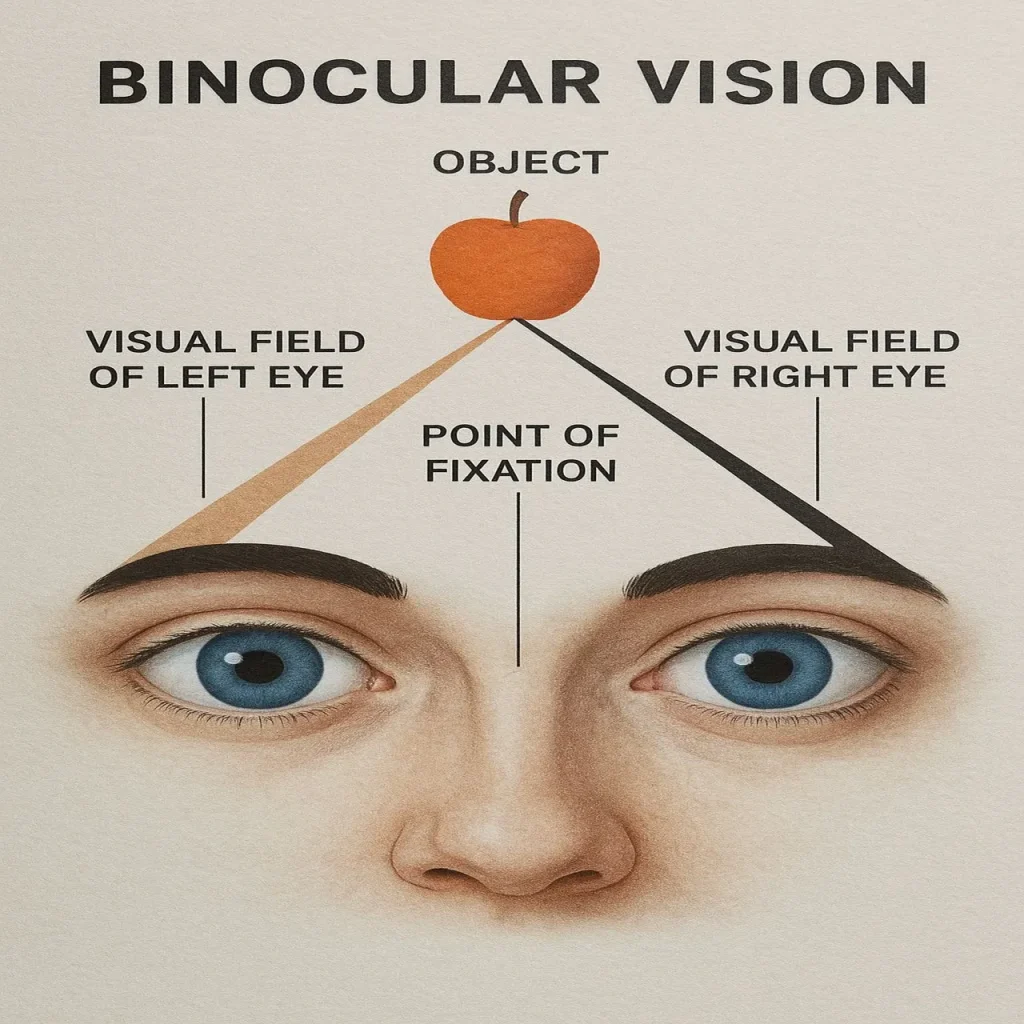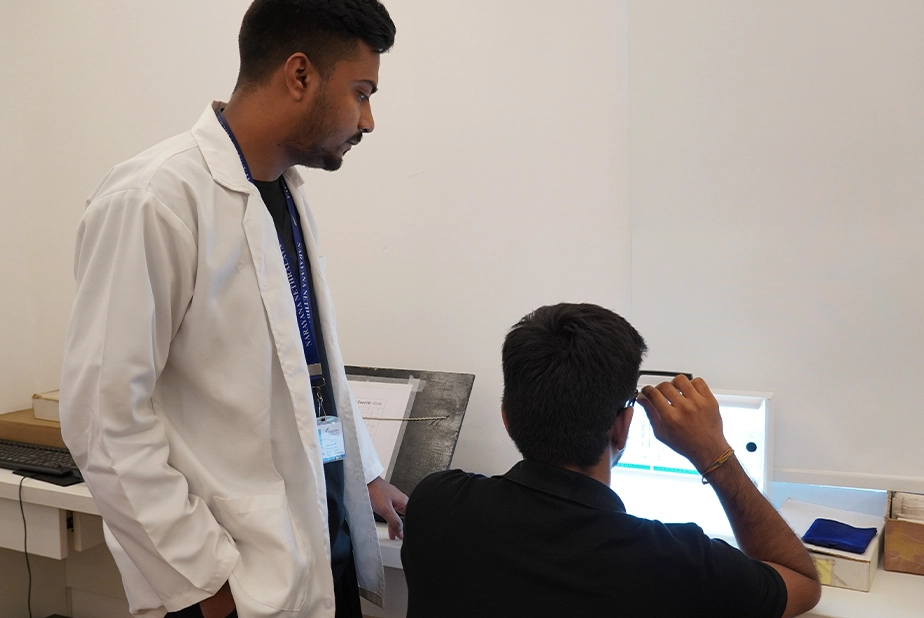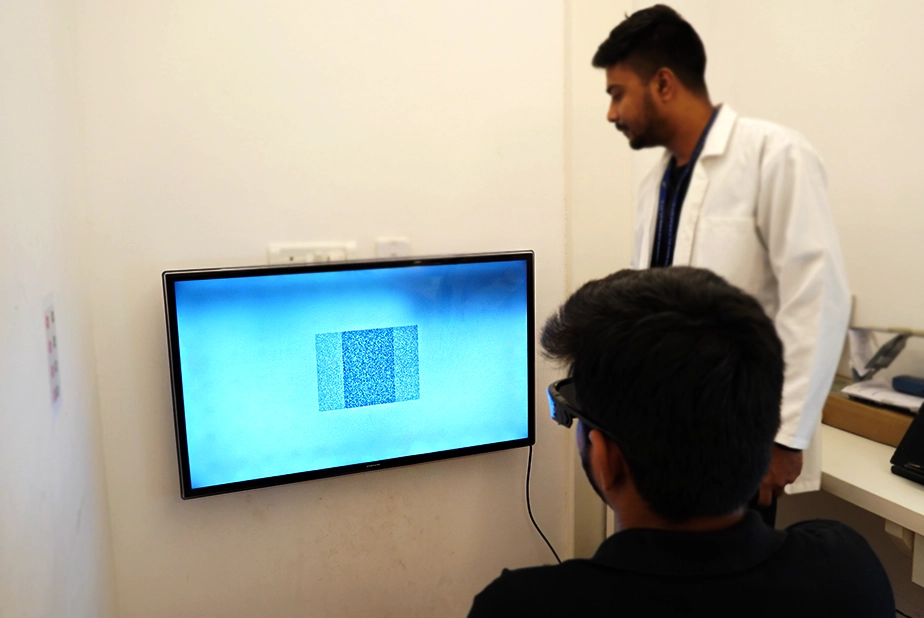Binocular Vision Clinic and Sports Vision Therapy
Understanding Binocular Vision
Binocular vision problems arise when the two eyes fail to work together as a team. In a healthy visual system, both eyes align and focus on the same object, enabling the brain to merge the two images into one with proper depth perception.
Common Binocular Vision Disorders Include:
- Convergence insufficiency (difficulty focusing on near objects)
- Accommodation anomalies (issues focusing at different distances)
- Strabismus (eye misalignment)
Why Do We Have Two Eyes?
Having two eyes offers many advantages:
- Wider field of vision
- Enhanced depth perception (3D vision)
- Improved distance judgment
These abilities support essential tasks like reading, navigating spaces, and judging distances. However, they depend on both eyes working in harmony.

How Binocular Vision Problems Affect Daily Life
Symptoms of binocular vision dysfunction include:
- Eyestrain or fatigue
- Headaches
- Blurred or double vision
- Difficulty focusing, especially on screens or books
- Visual discomfort during prolonged tasks
Left untreated, these problems can interfere with learning, reading, sports performance, and daily tasks.
Our Specialized Care for Binocular Vision Disorders
At our Binocular Vision Clinic, we offer comprehensive evaluations and advanced treatments. Based on your condition, we design personalized therapy plans using:
- Vision therapy
- Targeted exercises
- Treatment for convergence insufficiency, strabismus, and accommodation anomalies
- Cutting-edge diagnostics and tracking tools
Goal: To restore depth perception, visual clarity, and reduce visual fatigue.

Technology & Binocular Vision
Excessive screen time can place strain on the visual system, especially in children. Our team addresses technology-induced issues by offering proactive strategies and therapy to minimize long-term effects on binocular vision.

Now Eye Know Videos
What is Binocular Vision? and how to identify them, Its importance in daily life: Dr Sumitha Muthu
Frequently Asked Questions
How Do I Know If I Have a Binocular Vision Problem?
Common signs include:
- Double or blurred vision while reading
- Moving or jumbled letters on the page
- Eyestrain, especially with screens
- Difficulty concentrating or reading for long periods
These are often misattributed to tiredness or poor lighting—making proper assessment essential.
How Are Binocular Vision Anomalies Treated?
Treatment may include:
- Prescription glasses or prism lenses
- Vision therapy exercises
- Tools like:
- Difficulty concentrating or reading for long periods
Flippers (to train focusing ability)
Brock string (to improve eye coordination)
Computer-based programs (interactive training)
Treatment is tailored and results improve with consistent practice and guidance.
I have a busy schedule and I cannot come for office-based therapy. What are my options for treatment?
We offer home-based therapy options for those unable to attend regular in-clinic sessions:
- Take-home tools and therapy kits
- Online vision therapy software
- Remote guidance and progress tracking
This ensures flexibility without compromising treatment quality.
What measures should I take to ensure that my binocular vision problem does not recur after it is fully treated?
To maintain healthy binocular vision:
- Stick to prescribed exercises (taper under supervision)
- Practice good visual hygiene
- Maintain proper reading distance
• 14–16 inches for books
• 16–20 inches for digital screens
- Sit with good posture, using a supportive, comfortable chair
- Use proper lighting, preferably overhead and evenly distributed
- Follow the 20-20-20 rule: Every 20 minutes, look 20 feet away for 20 seconds
Sports Vision Therapy
Unlock Your Visual Edge in Sports
Sports Vision Therapy enhances athletic visual skills essential for high-level performance. It goes beyond routine eye care to focus on the demands of your sport—like tracking fast objects, reacting quickly, and judging depth accurately.
Why It Matters?
Top-performing athletes rely on:
- Depth perception
- Dynamic visual acuity
- Peripheral awareness
- Fast eye tracking
- Split-second reaction times
Even small improvements here can offer a competitive edge and reduce injury risks.

How Our Optometrists Help?
Our sports vision team provides:
- Detailed performance-based visual assessments
- Sport-specific eyewear (e.g., anti-glare lenses, contacts, protective goggles)
- Personalized training to improve:
Visual tracking
Eye-hand coordination
Field awareness and reaction time
Visual focus in fast-paced environments

Who Can Benefit?
Athletes of all levels—from age 6 to elite professionals—in sports such as:
- Cricket
- Football
- Table Tennis
- Badminton
- Shooting and Archery
- Athletics and more
Training is customized to your sport, age, and current skill level.

Train Your Visual Brain. Elevate Your Game.
Let us help enhance your sports performance, visual confidence, and long-term eye health. Reach out to begin your custom training plan today.
Frequently Asked Questions
I wear glasses. Do I still need vision training?
Yes. Glasses correct sight clarity, not how you process visual cues during sports. Vision training improves reflexes and coordination.
Will it help my child in cricket or football?
Absolutely. It boosts ball tracking, field awareness, and reaction time—essential for team sports.
How is it different from a regular eye check?
Routine exams assess clarity. Sports vision tests evaluate performance-related visual functions like tracking and reaction time.
Is this for indoor sports too?
Yes. Sports like badminton and table tennis benefit from dynamic focus and fast reflexes—which we train.
Is this a long-term commitment?
No. Most programs last 6–8 sessions, with occasional refreshers during active seasons.
Interactive & Engaging Training
Not just staring at screens. Training includes:
- Reaction light boards
- Balance platforms
- VR headsets
- Ball drills
- Tracking and coordination apps
It’s active, fun, and tailored to your sport.
I often lose track of the ball. Can this help?
Yes. Visual tracking and anticipation improve significantly with sports vision therapy.
I’m a shooter/archer. Can this improve focus?
Definitely. We target fixation stability, depth judgment, and attention control.
Is there an age limit?
No. Programs are available from age 6 and up, with content adapted to age and goals.
How soon will I see results?
Many athletes notice improvement within 2–3 sessions; full benefits after 4–8 sessions.